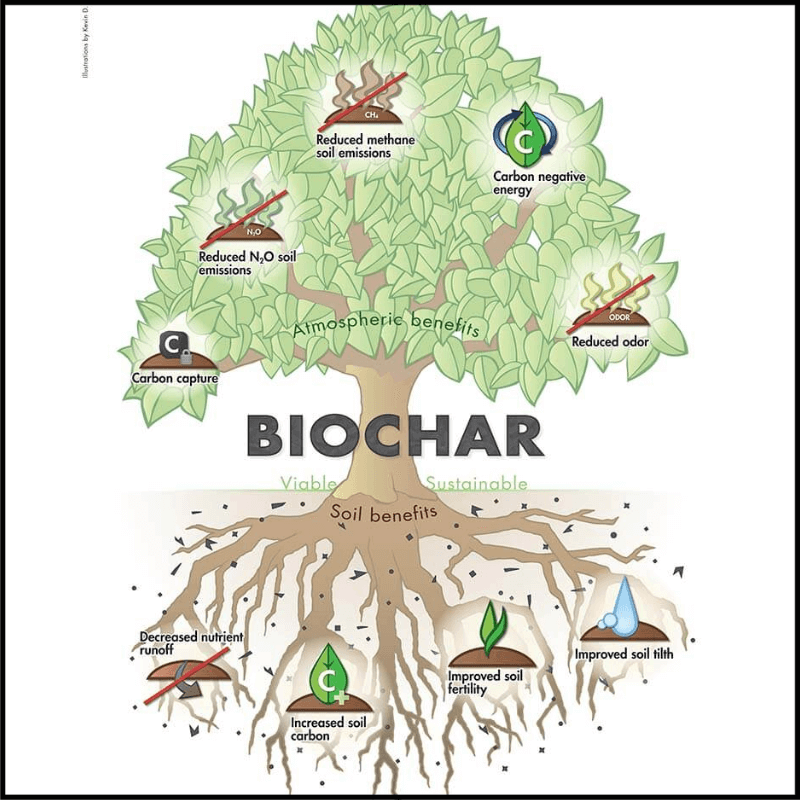
With the Indian Carbon Market scheduled for launch in 2026, biochar is emerging as a promising carbon dioxide removal (CDR) technology. Produced via pyrolysis of agricultural residue and organic municipal solid waste, it serves a dual purpose, managing waste sustainably and locking carbon in a stable form for centuries. Read here to learn more.
Annual Waste Generation in India:
- Agricultural residue: ~600 million metric tonnes (MMT)
- Municipal solid waste: ~60 MMT
Much of this is burnt or dumped in landfills, contributing to severe air pollution and GHG emissions (methane, nitrous oxide, CO₂).
Harnessing just 30-50% of this surplus waste could yield 15-26 MMT biochar/year, removing ~0.1 gigatonnes CO₂-equivalent.
Potential of Biochar in India
Biochar is a carbon-rich, porous material obtained by heating biomass (agricultural residues, forestry waste, organic municipal solid waste) under limited oxygen conditions, a process called pyrolysis.
Its potential in India lies in three interconnected domains:
- Climate Mitigation
- Biochar locks carbon in a stable form for hundreds to thousands of years, preventing its return to the atmosphere as CO₂ or methane.
- One tonne of biochar can sequester 5–3 tonnes of CO₂-equivalent emissions.
- Contributes to India’s net-zero 2070 goal and commitments under the Paris Agreement.
- Waste Management
- Can process 600+ MMT/year of agricultural residue and 60+ MMT/year of organic MSW, reducing stubble burning and methane from landfills.
- Soil Health & Productivity
- Improves soil structure, aeration, and moisture retention.
- Increases cation exchange capacity (CEC), enhancing nutrient uptake and reducing fertiliser runoff.
Byproducts of Biochar Production
Production via pyrolysis yields two other valuable products:
Byproduct |
Characteristics |
Potential Uses |
Syngas (CO, H₂, CH₄) |
A combustible gas mixture produced during pyrolysis |
|
Bio-oil |
Dark liquid containing phenols, acids, and bio-chemicals |
|
Example: A 1 tonne/day pyrolysis plant can produce ~300 kg biochar, 400 Nm³ syngas, and 100–150 litres bio-oil, enough to run a 50-60 kW generator.
In the Construction Sector
- Cement Replacement in Concrete
- It can replace up to 30% of cement in some mixes, reducing cement’s carbon footprint (cement production emits ~0.9 tonnes CO₂ per tonne).
- Lightweight Aggregate
- Porous biochar can be used as a lightweight filler in concrete, plaster, and insulation panels.
- Thermal & Moisture Regulation
- Acts as a natural humidity regulator in walls.
- Increases insulation, reducing building energy needs.
- Circular Economy Linkage
- Converts local biomass waste into construction-grade material, reducing reliance on virgin resources.
Why Biochar Remains Underrepresented in Carbon Credit Systems

- Measurement & Verification Challenges: Carbon permanence and sequestration efficiency vary by feedstock and production conditions. Difficulty in setting standardised MRV protocols for carbon markets.
- High Initial Costs: Small-scale farmers and waste processors cannot easily afford pyrolysis equipment.
- Policy Gaps: Current Indian carbon offset frameworks focus more on renewable energy and energy efficiency projects than carbon removal.
- Fragmented Supply Chains: Biomass availability is seasonal and region-specific, making year-round operations difficult.
- Awareness Deficit: Limited knowledge among policymakers, farmers, and industries about biochar’s co-benefits beyond carbon sequestration.
Enabling Large-Scale Adoption of Biochar
- Policy & Carbon Market Integration
- Include biochar explicitly in India’s Carbon Credit Trading Scheme (CCTS) with approved MRV methodologies.
- Offer upfront subsidies or tax breaks for pyrolysis plants.
- Decentralised Production Hubs: Promote village-level pyrolysis units linked with FPOs (Farmer Producer Organisations) to process crop residues locally.
- Byproduct Monetisation: Develop bio-oil upgrading refineries and syngas-fed mini-grids to improve project economics.
- Construction Sector Linkages: Mandate green material quotas in public infrastructure projects, enabling demand pull for biochar-based cement alternatives.
- Awareness & Capacity Building: National campaigns and training for farmers, municipalities, and construction firms on its’s applications.
- R&D Support: Fund research on improving yield, quality consistency, and integration with existing waste management systems.
Way forward
- Policy Integration
- Recognise biochar in the Indian Carbon Credit Trading Scheme (CCTS).
- Develop MRV protocols for permanence and quality verification.
- Technology & Infrastructure
- Region-specific R&D to optimise feedstock use.
- Promote decentralised pyrolysis units via Farmer Producer Organisations (FPOs).
- Market Development
- Incentivise biochar-based construction materials and wastewater treatment solutions.
- Monetise syngas and bio-oil to improve project viability.
- Employment & Rural Benefits
- Potential to create 5.2 lakh rural jobs.
- Reduce fertiliser use by 10-20%, increase yields by 10-25%.
Conclusion
Biochar is one of the few carbon-negative technologies that can simultaneously address waste management, soil restoration, renewable energy, and climate goals. For India, its large biomass base is a natural advantage.
However, mainstreaming it will require market incentives, technological standardisation, and cross-sectoral collaboration, linking farmers, municipalities, industry, and carbon markets in a single value chain.
Related articles:







Leave a Reply